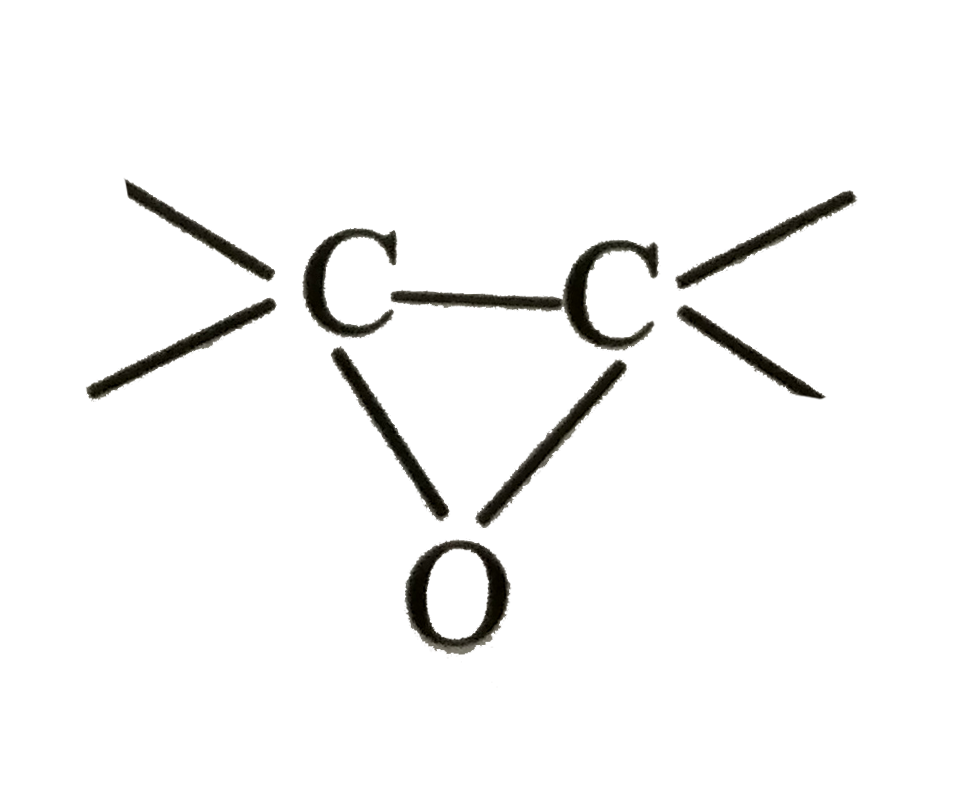Symmetrically subsituted epoxides give the same products in both the acid catalysed and base catalyzed ring opening. An unsymmetrical epoxide gives different products under acid catalysed and base catalysed conditions. Under basic contions, the alkoxide ion simply attacks the less hindered carbon atom in an SN2 displacement. Under acidic conditions, the alcohol, attacks the protonated epoxide.
_S01_404_Q01.png)
Structure II and III show that the oxtrane carbon share part of positive charge. The tertiary carbon bear a larger part of positive charge and it is more strongly electrophilic. The bond between teritiary carbon and oxygen is weaker implying a lower transition state energy for attack at the teritary carbon. Attack by the weak nucleophilic is sensitive to the strength of electrophilic is sensitive to the strength of electrophile. Center attack takes place at more electrophilic carbon which is usually the more substituted carbon because it can better support the positive charge.
_S01_404_Q02.png)
OH∣CH2−C∣CH3H−18OH
18OH∣CH2−C∣CH3H−OH
18OH∣CH2−18OH∣C∣CH3H
None
The correct Answer is:B
Step by step video, text & image solution for Symmetrically subsituted epoxides give the same products in both the acid catalysed and base catalyzed ring opening. An unsymmetrical epoxide gives different products under acid catalysed and base catalysed conditions. Under basic contions, the alkoxide ion simply attacks the less hindered carbon atom in an SN^(2) displacement. Under acidic conditions, the alcohol, attacks the protonated epoxide. Structure II and III show that the oxtrane carbon share part of positive charge. The tertiary carbon bear a larger part of positive charge and it is more strongly electrophilic. The bond between teritiary carbon and oxygen is weaker implying a lower transition state energy for attack at the teritary carbon. Attack by the weak nucleophilic is sensitive to the strength of electrophilic is sensitive to the strength of electrophile. Center attack takes place at more electrophilic carbon which is usually the more substituted carbon because it can better support the positive charge. by Chemistry experts to help you in doubts & scoring excellent marks in Class 12 exams.
Topper's Solved these Questions
- BOOK - ALLENCHAPTER - ALKENE, ALKANE & ALKYNE EXERCISE - EXERCISE-4(A)10videos
ALKENE, ALKANE & ALKYNE
- BOOK - ALLENCHAPTER - ALKENE, ALKANE & ALKYNE EXERCISE - EXERCISE-4(B)10videos
ALKENE, ALKANE & ALKYNE
- BOOK - ALLENCHAPTER - ALKENE, ALKANE & ALKYNE EXERCISE - EXERCISE-1119videos
ALKENE, ALKANE & ALKYNE
- BOOK - ALLENCHAPTER - AIIMS 2019EXERCISE - CHEMISTRY35videos
AIIMS 2019
- BOOK - ALLENCHAPTER - ALKYL AND ARYL HALIDEEXERCISE - EXERCISE-05 (B)37videos
ALKYL AND ARYL HALIDE
Similar Questions
Knowledge Check
- Question 1 - Select One
Epoxides are :
Aunsaturated ethersBmixed ethersCcyclick ethers with Dnot ethers
Dnot ethers - Question 2 - Select One
Epoxides are
AUnsaturated ethersBMixed ethersCCyclic ethers with
 DNot ethers
DNot ethers - Question 3 - Select One
Epoxides are
AEthers with another functional groupBNot ethersCAryl-alkyl ethersDCyclic ethers
Acid and Base Catalysed Nuclophilic Substitution Reaction
View Solution on acid catalysed hydration givesView Solution
on acid catalysed hydration givesView SolutionAcid catalysed aldol condensation involves
View SolutionThe product of acid catalysed hydration of 2-phenylpropene is
View SolutionThe major product obtained on acid-catalysed hydration of 2-phenylpropane is
View Solution


